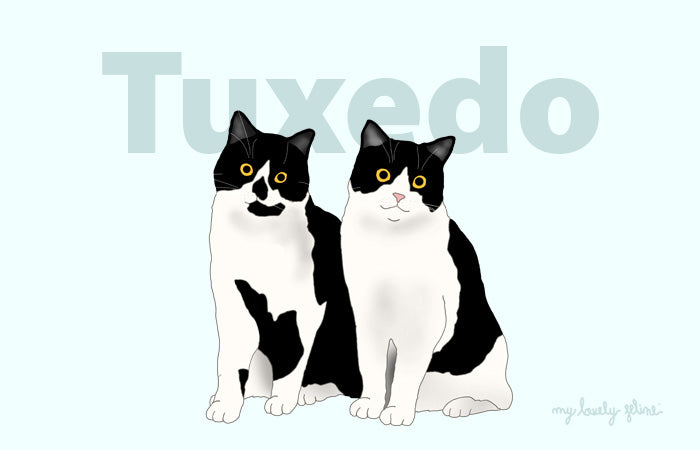—Feline Behavior Specialist 🇺🇸
|
Always dressed in their Sunday best, tuxedo cats, also known as moo or cow cats, display their black and white colors proudly. What determines a cat will be black and white? Is it true that cats with white spots and another color are genetically similar to tuxedos? We’re not only addressing these fabulous feline dressers, but we’ll include info about other two-colored kitties! |
What are tuxedo cats?
The answer to this question is more complicated than it seems.
Cats with one color plus any amount of white are called bicolor or piebald cats. From a pattern standpoint, tuxedo cats are technically mostly one color (can be black, orange, red, gray, tabby, or something else) with very small amounts of white possible on their chest, belly, paws, and face. This pattern does not only apply to black and white cats.
In the cat community, we tend to refer to all black and white cats as tuxedos. When we talk about tuxedos in this article, we are referring to all black and white cats.
Are gray and white cats similar to tuxedos?
Yes. All cats originate from the colors black and orange, and gray is a diluted form of black. And again, a gray and white cat is a bicolor or piebald cat, the same as a tux.
What are the most common breeds that recognize tuxedo cats?
Many breeds accept tuxedo cats, but a few common ones include American Shorthair, British Shorthair, Maine Coon, and Turkish Angora.
What color eyes do tuxedo cats have?
Tuxedo cats most commonly have green eyes because the gene that causes a tuxie has some connection to green eyes (scientists haven’t fully figured it out yet).
Are tuxedo cats mostly male or female?
They are just about 50/50. While calicos and tortoiseshells are nearly all females, and orange tabbies are mostly male, tuxedos are split down the middle.
Is it true tuxedo cats usually have white whiskers?
Yes, which stands out against any black on their faces.
What types of patterns exist for piebald cats?
There are many different patterns. Here are some of the most common ones:
- Mitted - All one color but white paws. This is believed to be related to a separate gene than the one that causes all other white spottings.
- White Locket - All one color except white on neck.
- Tuxedo - Mostly one color with small amounts of white possible on paws, belly, neck, and face.
- Cap-and-Saddle - Color on ears and patch covers the tail, rump, and some of the back.
- Mask-and-Mantle - Color from top of head to tail tip, and the rest is white.
- Magpie or Harlequin - Patches of color and white. Some have spotted throats that look like they’re wearing a bow tie (yes, it’s just as cute as it sounds).
- Van Pattern - All white except top of head and tail.
What causes a cat to have white spots?
Cats inherit one gene from their mothers and the other from their fathers. The white spotting gene, S, has to be inherited from at least one parent for white spotting to be seen on tuxedos or bicolor cats. The gene s does not result in spotting.
Here’s how it works:
- ss - No white spotting
- Ss - White spotting on areas like feet, nose, chest, and tummy.
- SS - White spotting will cover more than half the body. Small chance cat will be completely white!
What are tuxedo cats’ personalities like?
There doesn’t seem to be a connection between coat color and personality, but there are perceptions people have developed. Cat personalities really depend on their early lives, as well as paternal genetics, which we very often don’t know.
Are there any diseases that seem to be genetically tied to tuxedo cats?
Nope!
According to the Merck Veterinary Manual, the most commonly reported congenital and inherited defects in cats are:
- Cerebellar hypoplasia (CH) aka Wobbly Kitten Syndrome - Underdeveloped cerebellum (which controls mobility and balance)
- Eye and eyelid defects
- Heart defects
- Cryptorchidism - One or both testicles absent
- Polydactyl - Extra toes
In Closing
So now you know, tuxedos aren’t just black and white cats! Regardless of what the main color is, we think they are all dapper, perfect, and the best-dressed cats in the room.
Sources:
FelineLiving.net, Everything About the Tuxedo Cat – Facts, Genetics and Personlity.
Catster.com, 10 Facts About Tuxedo Cats.
IB.Berkeley.edu, Basic Genetics as Revealed by Cats.
NCBI.NLM,NIH.gov, Endogenous Retrovirus Insertion in the KIT Oncogene Determines White and White Spotting in Domestic Cats.
Article by Elizabeth Italia 🙋♀️
Cat Behavior & Fostering Specialist



